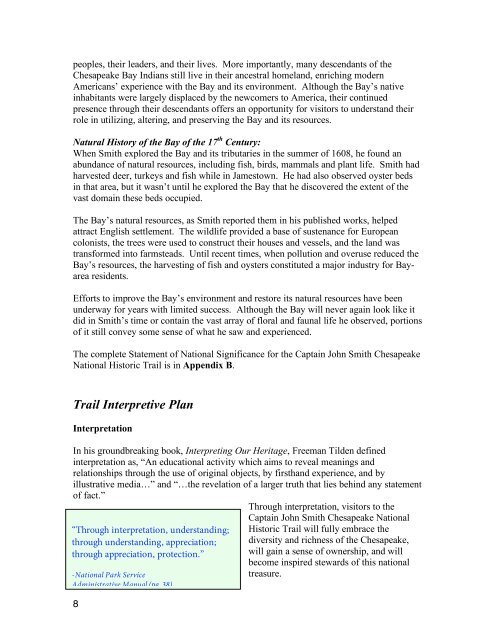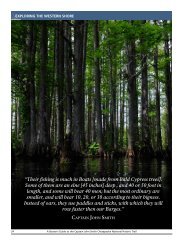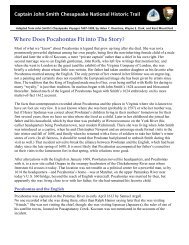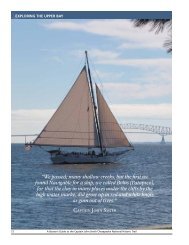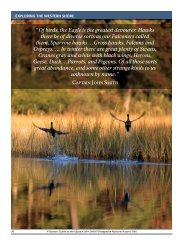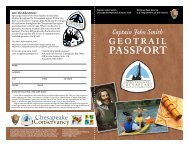Draft Interpretive Plan Join the adventure! - Captain John Smith ...
Draft Interpretive Plan Join the adventure! - Captain John Smith ...
Draft Interpretive Plan Join the adventure! - Captain John Smith ...
You also want an ePaper? Increase the reach of your titles
YUMPU automatically turns print PDFs into web optimized ePapers that Google loves.
peoples, <strong>the</strong>ir leaders, and <strong>the</strong>ir lives. More importantly, many descendants of <strong>the</strong><br />
Chesapeake Bay Indians still live in <strong>the</strong>ir ancestral homeland, enriching modern<br />
Americans’ experience with <strong>the</strong> Bay and its environment. Although <strong>the</strong> Bay’s native<br />
inhabitants were largely displaced by <strong>the</strong> newcomers to America, <strong>the</strong>ir continued<br />
presence through <strong>the</strong>ir descendants offers an opportunity for visitors to understand <strong>the</strong>ir<br />
role in utilizing, altering, and preserving <strong>the</strong> Bay and its resources.<br />
Natural History of <strong>the</strong> Bay of <strong>the</strong> 17 th Century:<br />
When <strong>Smith</strong> explored <strong>the</strong> Bay and its tributaries in <strong>the</strong> summer of 1608, he found an<br />
abundance of natural resources, including fish, birds, mammals and plant life. <strong>Smith</strong> had<br />
harvested deer, turkeys and fish while in Jamestown. He had also observed oyster beds<br />
in that area, but it wasn’t until he explored <strong>the</strong> Bay that he discovered <strong>the</strong> extent of <strong>the</strong><br />
vast domain <strong>the</strong>se beds occupied.<br />
The Bay’s natural resources, as <strong>Smith</strong> reported <strong>the</strong>m in his published works, helped<br />
attract English settlement. The wildlife provided a base of sustenance for European<br />
colonists, <strong>the</strong> trees were used to construct <strong>the</strong>ir houses and vessels, and <strong>the</strong> land was<br />
transformed into farmsteads. Until recent times, when pollution and overuse reduced <strong>the</strong><br />
Bay’s resources, <strong>the</strong> harvesting of fish and oysters constituted a major industry for Bayarea<br />
residents.<br />
Efforts to improve <strong>the</strong> Bay’s environment and restore its natural resources have been<br />
underway for years with limited success. Although <strong>the</strong> Bay will never again look like it<br />
did in <strong>Smith</strong>’s time or contain <strong>the</strong> vast array of floral and faunal life he observed, portions<br />
of it still convey some sense of what he saw and experienced.<br />
The complete Statement of National Significance for <strong>the</strong> <strong>Captain</strong> <strong>John</strong> <strong>Smith</strong> Chesapeake<br />
National Historic Trail is in Appendix B.<br />
Trail <strong>Interpretive</strong> <strong>Plan</strong><br />
Interpretation<br />
In his groundbreaking book, Interpreting Our Heritage, Freeman Tilden defined<br />
interpretation as, “An educational activity which aims to reveal meanings and<br />
relationships through <strong>the</strong> use of original objects, by firsthand experience, and by<br />
illustrative media…” and “…<strong>the</strong> revelation of a larger truth that lies behind any statement<br />
of fact.”<br />
Through interpretation, visitors to <strong>the</strong><br />
“Through interpretation, understanding;<br />
through understanding, appreciation;<br />
through appreciation, protection.”<br />
-National Park Service<br />
Administrative Manual (pg. 38)<br />
8<br />
<strong>Captain</strong> <strong>John</strong> <strong>Smith</strong> Chesapeake National<br />
Historic Trail will fully embrace <strong>the</strong><br />
diversity and richness of <strong>the</strong> Chesapeake,<br />
will gain a sense of ownership, and will<br />
become inspired stewards of this national<br />
treasure.


